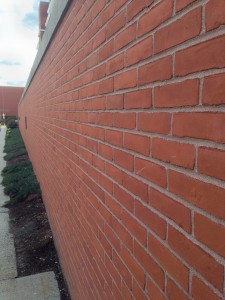How to Tackle the Writing Wall
 My first encounter with the running menace known as “the wall” happened at 1:00am on a humid July night in Wakefield, Massachusetts. My sneakers were slapping sandy pavement littered with discarded paper cups. The taste of the twilight summer gnats thronging Lake Quannapowitt was still fresh between my teeth. In the sixth hour of the Around the Lake marathon, I was so exhausted that my body had stopped responding to the heat.
My first encounter with the running menace known as “the wall” happened at 1:00am on a humid July night in Wakefield, Massachusetts. My sneakers were slapping sandy pavement littered with discarded paper cups. The taste of the twilight summer gnats thronging Lake Quannapowitt was still fresh between my teeth. In the sixth hour of the Around the Lake marathon, I was so exhausted that my body had stopped responding to the heat.
The sweat had stopped coming an hour before, and my skin was covered in dry, salty streaks. My plodding footfalls slowed to a shuffle when I spotted a rock trailside, under a streetlamp. It was the perfect size and shape for sitting, at mile 25 of 26.2.
I gave in. Under the orange glow of the streetlamp, I sat down, released the tension in my aching legs, and cried.
In the heat of that July night, I had hit “the wall,” a stupifying force that congealed like gelatin around my legs, slowing my heart rate and fogging my mind.
When was the last time you hit the wall as a writer?
Maybe without the histrionics, the salt streaks and the tears, but writers? We know the wall. We hit it all the time. It’s writer’s block, writer’s doubt, the not-finishing disease. Maybe writers don’t sit down on rocks and cry, or accidentally inhale some gnats on our way to publishing a piece of writing, but, God, the wall hurts just the same.
“The wall” is the nickname distance runners have for what happens to your body when you run out of glycogen, your muscles’ essential fuel source, faster than your body can replenish it. It’s a fearsome foe. Marathons are expensive and time-consuming, and no one wants to quit, or to finish it crawling on all fours.
So, what of tackling the wall in your writing? I’ve learned that the kind of advance planning runners employ during marathon training has helped me as a writer to avoid the dreaded writing wall. Here are some ideas.
1. Commit obnoxiously, the moment you decide to write. During my marathon, two things helped me get back up once I sat down. Once I signed up to run, I told everyone I knew, and I booked a hotel room at the only hotel available near the finish line–a business-class Sheraton. Quitting and calling for a ride to the finish line would have not only wasted the support of my loved ones in the months leading up to the race, it would’ve wasted what I paid for my hotel room.
Similarly, setting up high stakes at the outset of your writing project might seem daunting, but think of it as insurance against failure when you see that figurative rock during the first-draft doldrums or when you receive the first rejection letter in your inbox. You’re going to keep plugging away for what you want, because you’ve designed your own system of consequences.
Masochistic? Maybe. But you’ll write more.
2. Plan ahead for self-care. One of the biggest problems with NaNoWriMo (for Americans) is that Thanksgiving falls in the home stretch of November, when you should be hyper-focused on your word count and shaping your novel’s denouement. The inexperienced writers vow to power through it, putting the laptop on the kitchen counter to write and bake at the same time, or tapping on iPads under the table at Thanksgiving dinner. This is madness.
Marathoners in training schedule things like massage sessions and doctor appointments in the weeks leading up to a race. Your self-care needs as a writer should also be appointments. Whether it’s quiet time (hire the babysitter. Call the mother-in-law), budgeting for the professional proofreader, or simply taking that much-needed walk when you know you’re all tangled in your work, do not skip these practices. You’re building your inner reserves for the moment when you…
 3. Welcome the wall when you see it coming. Problems tend to crop up at the tenderest point of any creative endeavor, and the fact that you feel your flow slowing to a dribble is a good sign. Like the runner who knows she’s at mile 22 because her legs are screaming for mercy, meeting your resistance means you are getting ahead. You’re moving.
3. Welcome the wall when you see it coming. Problems tend to crop up at the tenderest point of any creative endeavor, and the fact that you feel your flow slowing to a dribble is a good sign. Like the runner who knows she’s at mile 22 because her legs are screaming for mercy, meeting your resistance means you are getting ahead. You’re moving.
4. Realize that the wall is ultimately temporary. Once I got up off the rock, I didn’t have the energy left to run, so, with 1.2 miles to go, I walked. When I rounded the last turn before the finish line, I broke into a slow, painful jog. It was taking everything I had to keep moving, and dammit, I was going to cross that finish line moving like a runner.
It wasn’t a photo finish, but the wall was already just a memory. When you’ve hit the wall in your work, forget about your word counts. Forget about your creative flow, and forget about feeling competent. Your only task, like putting one foot in front of the other, is to keep putting words down on the page. Even if they’re only coming one by one, more slowly than seems possible, you’re taking the wall apart, brick by brick. You’re winning.
How do YOU fight through the wall in your art? Avoid it, jump over it, power through it? Let me know what you think!
***
Shanan Haislip is a full-time business writer, essayist and webmaster at The Procrastiwriter www.theprocrastiwriter.com, a blog about being a writer around a full-time life (without going insane). She still runs marathons now and then. Follow The Procrastiwriter on Facebook www.facebook.com/theprocrastiwriter or on Twitter at @Write_Tomorrow.
Category: Contemporary Women Writers, How To and Tips






























